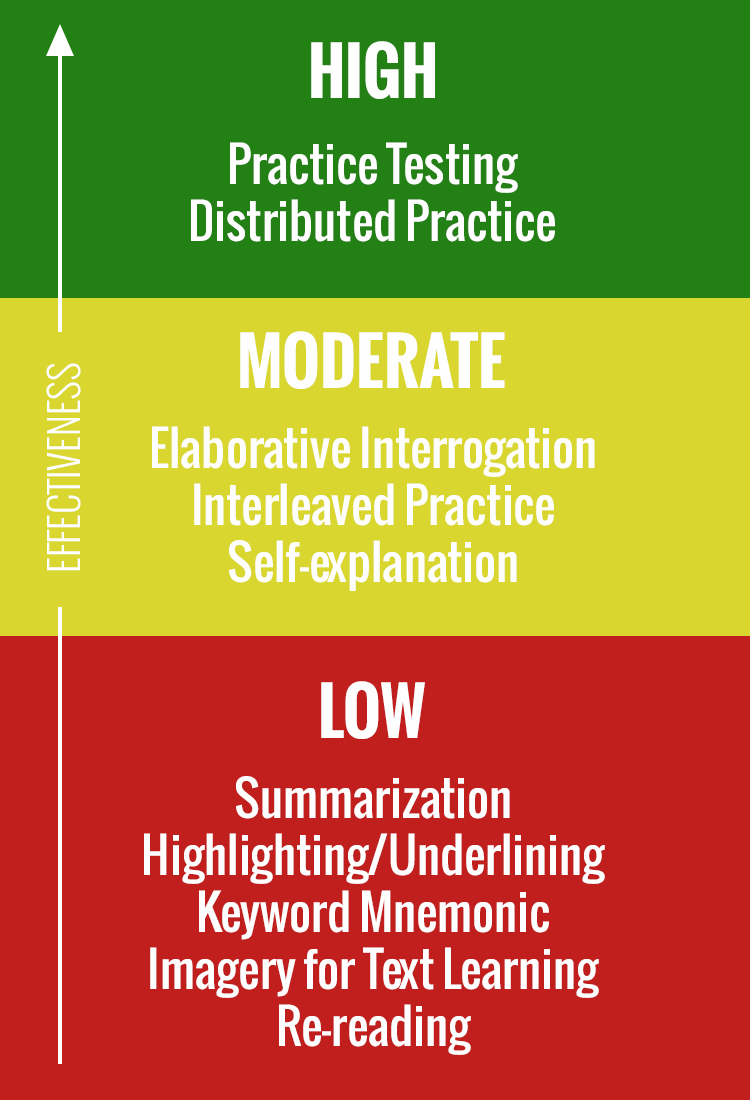There’s so much to learn out there and only so much time.
I literary have a list of things I’d love to explore: statistics, artificial intelligence, game design, drawing, data visualization, animation, programming… you get the idea.
While it’s hard for me to pick and choose what to focus on, I’ve learned that meta-skills supersede any of these.
What’s a meta-skill? A meta-skill is essentially a higher-order skill that enables and empowers other skills to happen. They are the foundation on which you are able to engage with new skills effectively.
There are many different meta-skills, from self-awareness to confidence to critical thinking to empathy. Some of these can be thought of as soft skills, but they are anything but soft. They are abilities that inform everything you do and apply to all facets of your life.
You can see why they’re so important. Of the many meta-skills, there’s a single one that reigns supreme: the ability to learn.
Knowing how to learn is what allows everything else to happen, even the development of other meta-skills are derived from our ability to learn.
If you know how to learn, picking up data visualization or animation or philosophy are that much easier. If you don’t, they become much more challenging endeavors.
Of all the things we’d hope to learn in school, this would appear to be the most important. Unfortunately they don’t do the best job. Then the question becomes, how do you learn how to learn? That’s what we’ll begin to explore next.
____________
T
here are many different ways to go about the process of unlocking how to learn and each offers a piece of the puzzle. The following are a few of those puzzle pieces, which will help you learn more effectively.
Studying Techniques
Understanding how to study is probably one of the more important parts of the learning process. Everyone studies in their own way, but have you ever wondered which way was the best?
A research paper published in Psychological Science in the Public Interest journal gives us a good place to start. In the paper they explore 10 different study techniques and their relative effectiveness. The techniques studied include:
Highlighting/Underlining: one of the most popular and easily accessible methods, consists of marking up text that is important
Elaborative Experimentation: developing explanations for why things are true, rather than what they are
Summarization: the process of summarizing information into a few concise sentences
Practice Testing: applying your knowledge to the real thing, whether its a task or a test, exhibits what you know
Keyword Mnemonic: linking ideas or information to words that add further meaning
Imagery for Text Learning: linking ideas or information to visual images in the mind
Re-reading: reading information again and again
Self-explanation: explaining the process of problem solving to better understand decisions
Distributed Practice: learning over time to improve recall and lasting learning
Interleaved Practice: studying problems of different types, rather than blocking similar problems together
They don’t cover every single study technique out there, but I’m sure a lot of them are familiar to you. What’s interesting is that each study technique is not created equal. In fact, there are some clear cut winners from this bunch. You may be surprised to find some of your favorite techniques in the red, but that doesn’t mean they aren’t useful. There are certain situations where every technique is effective, especially if you have mastered them. This is certainly the case for me when it comes to summarizing information.
You may be surprised to find some of your favorite techniques in the red, but that doesn’t mean they aren’t useful. There are certain situations where every technique is effective, especially if you have mastered them. This is certainly the case for me when it comes to summarizing information.
Even so, what’s most interesting are the two that came out on top: practice testing and distributed practice.
Practice testing makes sense, after all, there’s nothing quite like actually doing the thing that we’re studying towards. Unfortunately, we tend to avoid self-testing because it makes us uncomfortable, despite it’s obvious benefits.
To get the most out of learning, we should be testing ourselves all the time, whether we make up the tests ourselves or have practice tests available. There is no other way to truly evaluate what you do and do not know. As they say, you learn best by doing and testing is one of the ways to do.
The other major technique is distributed practice, which is essentially spacing out your studying over a longer period of time. The benefit to spreading out your learning is that you improve recall and the length of time said information will be remembered.
Yet, we all know our good friend procrastination has a problem with this. More often that not, we end up with late night cram sessions, rather than efficiently scheduled study time.
If we can change our study habits though, you can greatly improve how well you retain information by spreading it out over weeks and months, rather than hours.
The point here is not to completely change your study habits, as you’ve probably mastered your personal preferences to some extent already. Instead, it is to add in some of the more effective methods identified here. It certainly wouldn’t hurt to plan out your study sessions and self-test a little more often than you do. You can learn more about the study techniques here.
Learning Styles
I’m sure you’ve heard of learning styles, but then who hasn’t? The thing is, they don’t amount to much when you look at all the research.
In fact, matching teaching style to learning style doesn’t really help much at all, yet there are still important takeaways to find from this idea.
First there is the premise that everything you learn has an ideal method for teaching or style. Learning to play a sport by listening isn’t going to get you very far. Similarly, learning how to play music by reading isn’t ideal. Despite any individual learning method, there is an optimal way to learn any skill. Furthermore, there is evidence that based on your skill level, how you learn is actually impacted. Novices tend to learn better through examples, while the practiced individuals learn better through actual problem solving.
Furthermore, there is evidence that based on your skill level, how you learn is actually impacted. Novices tend to learn better through examples, while the practiced individuals learn better through actual problem solving.
Despite how enticing it may be to understand your learning style, it’s not really all that useful. Instead pay attention to what you are learning and what best fits with that domain.
Embrace Ambiguity
A big part of learning comes from the mindset you are in when doing so. You have to understand that you’re walking into unknown territory and that you’re not going to know all the answers.
You’re a novice, an amateur, and that means that you need to not only be OK with ambiguity, but embrace it. In Zen Buddhism, this mindset is defined by the term Shoshin or beginner’s mind.
The premise of the beginner’s mind means being open, letting go of all preconceived notions, and embracing the unknown. You have to understand that you’ll struggle and get stuck and fail, but that’s perfectly acceptable because how else will you learn.
It is a vulnerable place to be for anyone, when you know you’re just beginning a journey towards knowledge, but the more comfortable you are with it, the better your learning experience becomes.
Follow Your Curiosity
Most learning wouldn’t happen without curiosity. Curiosity draws you to new ideas and fields and domains.
We can be curious about much on the surface, but once we dive in head first, we quickly realize if that thing is truly something we desire. This is where interest comes into play. If we think of curiosity as your guide, then interest is what makes you stay and strive for the knowledge you seek or simply give up.
Curiosity is the wick in the candle of learning.William Arthur Ward
If you have no interest, whether it’s internal (personal desire) or external (necessary for career), you’re not going to learn much. Everything worth learning is difficult, but if you truly are interested and committed, you’ll stick to it.
Imagine you were learning biology, but you absolutely hated it. Perhaps you thought it would be interesting, but it’s just not your cup of tea. How likely are you to keep at it? Not very.
Instead you should use your curiosity and interest to point you in the right direction for learning. It will show you the things worth chasing and steer you away from those that aren’t right for you. The key is to not force learning in areas that you lack interest.
Zoom In, Zoom Out
As with anything you learn, you’re going to get stuck at some point in time. A concept just won’t make sense or you’ll face a problem you simply can’t crack. That’s when it’s best to use a simple technique I like to call Zoom In, Zoom Out.
When you’re learning you first zoom in, you focus on the problem in front of you and you drive forward. That is until you get stuck. When this happens (trust me it will), the answer isn’t to focus further and bang your head against the wall, rather it is to take a step away, to zoom out.
When you do this, you not only give your mind a break, but you allow your subconscious to start exploring the problem and finding a solution without your attention. This process is very similar to what we do when we procrastinate because we’re not ready to move forward on a project or problem.
There are many ways to follow this approach from simply being aware of when you are stuck or employing techniques like the pomodoro. However you do so, it is an important lesson for learning.
When you’re stuck, take a break and distract yourself. When you come back to the task at hand, you’ll be surprised how different things may appear.
Technology
While this isn’t really a technique, I think it would be a mistake not to point out how much technology can offer us when it comes to our learning.
The wealth of resources available to us, from Google to discussion forums to YouTube videos, the knowledge at our fingertips is endless. What’s important then is that we leverage this resource and to do so, we need to be literate when it comes to technology.
Being tech savvy and able to use our current and future technology, provides us a means to access people, information, and tools that all enhance our learning.
Learning how to learn is life’s most important skill.
These methods just scratch the surface of understanding how to learn, as there are many techniques, new and old, that are worth exploring.
More importantly, despite any techniques, understanding how we learn as an individual is something that happens over time, as we notice our own tendencies and habits and strengths and weaknesses.
The key is to realize just how important learning is and to take some time to perfect it because it truly does shape the rest of our lives.
